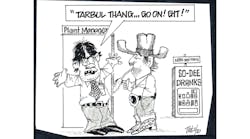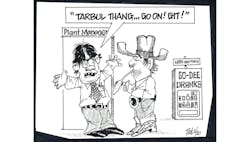This Control Talk column appeared in the March 2020 print edition of Control. To read more Control Talk columns click here or read the Control Talk blog here.
Greg: The dozens of experts I knew who led the many advances in instrumentation, modeling and control at major chemical companies such as Monsanto and DuPont, and at automation system suppliers such as Fisher Controls and Foxboro, are retired. Nearly all of the remaining experts I know are eligible for senior discounts. I especially miss Greg Shinskey and my colleague Terry Tolliver, who I consider leaders in PID control. I am nearing the end of the line myself after 50 years in the process industry starting out in instrumentation and electrical (I&E) design and construction, moving on to engineering technology at Monsanto and then process control improvement at its spin-off Solutia, and ending up in research and development at Emerson.
I see a huge gap in expertise between the peak in publications by these experts and the resulting advances in improving process control and now. It's extremely strange that all the books by Greg Shinskey are out of print by the publishers. The mistaken opinion that we have made all the advancements in process control to be made—expressed by some and implied by the IIoT being the total future solution—has been damaging. The loss of expertise at the management level has furthered the lack of recognition of opportunities in process control improvement, resulting in an emphasis on schedule and budget and more data. Nothing could be further from the truth, just based on what new expertise and associated opportunities I've developed in the past 10 years. I’m seeing go largely untapped the power of instrumentation that has an order of magnitude better accuracy, and configurable controllers that have an order of magnitude more functionality.
I'm doing what I can to stop this trend. I'm writing feature articles and Control Talk columns capturing the expertise of practitioners before they exit the scene, giving presentations at key conferences, updating my ISA books, leading the ISA Mentor Program with Hunter Vegas, and forming the ISA 5.9 Standards and Practices (S&P) committee to generate a technical report on PID Algorithms and Performance. I'm hoping to make difference—but time is running out.
The enthusiasm and participation by more than 50 members in the ISA Mentor Program and over 30 members in ISA S&P 5.9 offer a ray of hope. To help provide some guidance and motivation, I offer the following conversation with a protégé.
If you are successful, my career is successful.
Protégé: What basic understanding do I need?
Greg: Engineers tend to operate in a box made of project time and money objectives. You need to think outside the box. Copy jobs are a step backwards in time. The cheapest instrumentation is not the best. The increase in price is insignificant compared to the increase in maintenance cost and the potentially much larger cost of a loss in process performance. Understanding the real price you pay is critical. Instrumentation provides the window into the process. Automation provides the means of affecting the process, but is only as good as the measurements, controllers and the final control elements (e.g., control valves and variable frequency drives).
The worst disturbances are self-inflicted in terms of variability caused by deficiencies in instrumentation and automation. Most of the process disturbances arising from changes in raw materials and environmental conditions (e.g., day to night) are slower and thus easier to handle. The sudden changes caused by instrumentation, interlocks, sequences, setpoint changes and manual operator actions, and the oscillations from interaction and limit cycles are most disruptive.
Protégé: How can I reduce process variability with better instrumentation?
Greg: Repeatability, resolution, rangeability, reliability and response time (5Rs) are most important. While offsets can be corrected by upper loops and by calibration, you're stuck with the sudden changes caused by scatter from poor repeatability, the steps and limit cycles from a resolution limit, the noise and erratic readings when exceeding rangeability, dramatic losses from failures by reliability deficiencies, and the dead time from slow response times.
For example, resistance temperature detectors (RTDs) have much better repeatability, resolution and rangeability than thermocouples. Instrument selection and installation should still minimize offsets, especially when caused by significant drift, and correction by calibration requires removal of the sensor from the process. Drift is an order of magnitude less for RTDs (besides the sensitivity being an order of magnitude better), which is important because upper temperature loops require tight control at the right operating point, and calibration requires sensor removal and insertion in a bath or dry block. Thermowell design and installation sets reliability and response time.
Magnetic flowmeters and especially Coriolis meters have much better repeatability, resolution, rangeability and reliability than differential head meters and vortex meters. The installation cost is lower, and the maintainability and accuracy are much better as well through the elimination of impulse lines and piping system requirements for upstream and downstream straight lengths.
High-temperature glass electrodes and good installations practices can eliminate reliability and response time problems in pH measurements due to aging and coatings. Sliding stem control valves with ultra-low friction (ULF) packing, diaphragm actuators and a ratio of valve to system pressure drop greater than 0.25 provide the best resolution and rangeability. If rotary valves are needed due to plugging or size, splined connections instead of pinned or keylock connections of actuator shaft to stem and a stem integrally cast with ball or disk greatly reduce backlash that comes into play with resolution limit. Digital positioners tuned with high gain (no integral) action with a volume booster if necessary on the positioner output with a slightly open bypass valve offer the best response time.
Never use valves designed for minimum leakage as throttling valves. These valves, originally designed for on-off service, are attractive from a standpoint of price and as well as capacity, but have terrible resolution. They'll often lie to a smart positioner through a shaft feedback that doesn't match actual plug, ball or disk position due to linkages and connections and types of actuators and excessive seat or seal friction. Use tight shutoff valves in series with throttling valve for isolation. It's important that the timing and speed of the throttling valve opening and closing be coordinated with that of the isolation valve to prevent hammer, flashing and plugging.
Read the Control Talk columns “A meeting of minds” and “Meeting of minds encore” for much more on the best temperature and pH measurement design and installation practices, plus the importance of these best practices for process performance. Then read the Control feature article, “How to specify valves and positioners that don’t compromise performance” for a detailed look at how to ensure every aspect of a control valve design (e.g., actuator, positioner, booster, connections, packing) and associated PID tuning and options (e.g., external-reset feedback) are optimized to get the most out of associated measurements and automation.
Protégé: How can I reduce process variability by better automation?
Greg: A control loop can't stop the effect of a disturbance until it sees the disturbance and affects the process at the point of proper correction. This corresponds to the total loop dead time. If the total loop dead time were zero, I would be out of job because tuning could provide immediate and complete correction (assuming the 5Rs were not a limitation). Instrumentation and automation is the largest source of dead time in most loops. The good news is this is under your control and you can determine your own fate. Minimize the dead time created by lags and delays due to poor control valve designs just noted, sensor response time, transportation delays due to sensor and transmitter damping settings, signal filter times, and update or execution times of transmitters and controllers. Realize that resolution limits create a dead time that's the percent resolution limit divided by the signal percent rate of change.
Use feedforward and ratio control and tuning of control loops to provide the best correction for load disturbances that are on the process input. Most disturbances are not on the process output as seen in many control theory textbooks, which means that correction needs to arrive on the process input at the same time and size with opposite sign as the disturbance. Feedforward dynamic compensation and tuning to reject disturbances are important. Minimize oscillations from interaction and resonance with other loops and violation of the cascade loop rule that the secondary loop must be five times faster than primary loop by tuning and PID options, such as external-reset feedback noted in the Control Talk blog “Missed Opportunities in Process Control - Part 3”
Work with operations and process engineering to get the best control strategy and online metrics to achieve process objectives using a pairing of controlled and manipulated variables that gives the best compensation of load disturbances as seen in the relative gain array. Use a digital twin for exploration, development, prototyping, testing, training and continuous improvement.
[javascriptSnippet]
You learn the most from your mistakes. The digital twin provides a great opportunity for finding and correcting them, greatly enabling innovation. Become best friends with the operators by communication and support in training and in the control room. Develop and implement online metrics in the digital twin, and incorporate them in the operator interface to show with a moving average the process efficiency and capacity for the shift and month and batch or unit run time for a particular product. See the Control feature article “Virtual plant virtuosity” and the Control Talk column “Simulation breeds innovation” for much more on the opportunities presented by the digital twin.
Eliminate manual and incorrect actions by operators. Develop procedure automation and state-based control in the digital twin, and deploy to automate the special actions needed during startup and transitions, and to deal with abnormal operation, including equipment and instrumentation failures. Improve the human-machine interface (HMI), state-based alarms and alarm management, so the operator isn't misled and knows exactly what needs to be done and if the automation system is doing its job or needs help. The HMI and operators must provide details of deficiencies for system improvements. Note that automation greatly helps improve the repeatability of corrective actions, enabling a much better diagnosis of problems and identification of corrections needed.
Automation offers a very repeatable response (again, assuming the 5Rs are not a limitation), transferring variability from important controlled variables (e.g., process outputs) to manipulated variables (e.g., process inputs). Thus, manipulated variables must be included as inputs for data analytics and synchronization with uncontrolled process outputs done for continuous processes. Use a digital twin with first-principle models to help determine whether correlations identified by data analytics are truly cause-and-effect relationships. Improve the selection and synchronization of process inputs and outputs by exploration with a digital twin. Please do not just dump data into data analytics and expect miracles. You need process understanding and good instrumentation and automation.
Avoid the common mistake of using too little proportional action and too much integral action in the PID controller. Integral action has “no sense of direction” and doesn't reverse direction of action until the controlled variable crosses setpoint, causing overshoot. If the product of the gain and reset time setting is smaller than four divided by the inverse of the integrating process gain for near-integrating, true integrating and runaway processes, very slow and large nearly undamped oscillations will result. Most people think too high a PID gain causes oscillations and try to reduce the gain, making the oscillations worse. The solution is to first increase the reset time by one or more orders of magnitude to see if you have violated this window of allowable controller gains. If you need more control action, you then need to see how much you can decrease the reset time setting without starting an oscillation. If you still need more feedback correction, try to increase the PID gain setting.
Protégé: How can I convince management of the value of process control improvement?
Greg: Go beyond your job script. Develop examples with online metrics in the digital twin with a first-principle model and the imported automation system plus a modeling of the 5Rs to serve as a dynamic working example showing the monetary value of increased process efficiency and/or capacity. You may need to do this on your own time. To develop knowledge of what's truly important to improving the process and automation system, read articles and books by Greg Shinskey and key members of ISA S&P committees. Ask ISA to include you as a member in an S&P committee like ISA 5.9, and if you are a practitioner, ask ISA to become a protégé or resource in the ISA Mentor Program. Invest in doing the best with best instead of focusing on doing the least with the least. Share your knowledge through presentations and publications to help advance the recognition of our profession. Realize that historical experts are history, that they're busy visiting historical sites, and that you are the future. Check out my keynote speech presentation “The Future is here” for the 75th Texas A&M Instrumentation and Automation Symposium in the Process Industries to gain ideas to on how to advance yourself and our profession.
10. Ah hurd yew are fixing to buy cheapest instruments. Tarbul thang. Go-on git.
9. Ah hurd yew not gonna use positioners. Tarbul thang. Go-on git.
8. Ah hurd yew say I-O-no 5Rs. Tarbul thang. Go-on git."
7. Ah hurd yew hav no mahterayul for checking calibrations. Tarbul thang. Go-on git.
6. Ah hurd yew ruthur learn to use a digital twin. Tarbul thang. Go-on git.
5. Ah hurd yew r ignernt in PID tuning. Tarbul thang. Go-on git.
4. Ah hurd yew gonna go for cost instudda performance. Tarbul thang. Go-on git.
3. Ah hurd yew kaynt spake with operators. Tarbul thang. Go-on git.
2. Ah hurd yew fergut or frayed to spake with process engineers. Tarbul thang. Go-on git.
1. Ah hurd yew only do what zekatuvs want. Tarbul thang. Go-on git.







